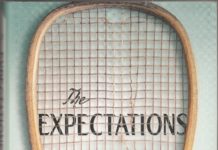By Will Carlin
My high school squash notebook looks like a rainbow. For some unremembered reason, I was rigorous about keeping my notes in a different color each day. Not just any color: they had to proceed systematically according to the color of the rainbow. Red one day, orange the next. Yellow followed by green and then by blue. Purple finished one sequence and started the next.
If you flip through the notebook, the colors are faded (the yellow entries are invisible), but the effect is slightly psychedelic.
The entries, however, are not. I recorded my opponent and the score of every practice match, every school match and every tournament match. Each score was followed by a P for “poor,” M for “medium,” or G for “good.” Next to that, in a narrow cursive script that I barely recognize, I wrote about the match—sometimes strategically, often emotionally.
On days without matches, I wrote what I worked on in practice. I wrote what I did well and what needed work. I wrote down accomplishments and frustrations. I wrote self-affirmations and self-exhortations. I chastised myself and cheered myself on.
Many of the entries were examples of a seventeen-year-old’s immaturity (already evident from the color wheel of entries). I had one set of pens. They were important. I used them until their ink reservoirs were dry.
My first notebook was a tennis notebook kept at the behest of my first tennis—and, later, squash—coach, Fred Weymuller. He impressed upon me that I would improve more quickly if I wrote down the things I learned. I was resistant, but Mr. Weymuller checked it regularly, so I did as I was told.
Later, I read a book called Smart Squash: Using Your Head to Win by Austin Francis. Tucked away in the middle is a chapter called “Niederhoffer’s Notebook.” Vic Niederhoffer was one of the all-time great players in history. He won the junior nationals, the intercollegiates, the men’s nationals and the North American Open. In short, he became the best player at every level in which he competed.
Each chapter in Francis’s book was headed by a cartoon drawn by Michael Witte. The one at the head of the Notebook chapter showed Niederhoffer sitting against the wall of a squash court, racquet balanced beside him, scribbling in a little black notebook. That drawing spoke to me, and I began to obsess over my notes. Niederhoffer’s were a revelation:
“6/9—First day of vacation from daily practice in nine months. Getting soft.” Forty years later, I still remember that one.
“6/15—Worked on cross-court shot, trying not to hit the side wall. Must put more outside spin on ball to keep it off. Body not moving very well. Was using new racquet. One of the worst losses ever. Felt pain in stomach when we started. Incredibly small margin between winning and losing. Sow the wind, reap the whirlwind. Am I getting old? Greenberg almost knocked me over.”
Don’t you just want to read more? Wasn’t this a little part of Niederhoffer’s greatness?
Richard Millman requires that every participant in a Millman Experience course keep a notebook. Richard often tells how one of his students said that he didn’t need one because he would remember. After the 45-minute lesson, Richard quizzed the young man: “So, what did you learn just now?”
The student stammered. Richard suggested something. “Yes, that was a good one.”
Richard asked for another. And another and a few after that. His point was that lessons are internalized more effectively if they are written down. The student showed up next time with a notebook.
Taking notes in school has been proven to work for students at all levels. It’s odd that it isn’t a staple for athletes. Many of the world’s elite athletes keep notebooks. They just don’t talk about it very much.
“Writing down your feelings in a notebook or journal can help clear out negative thoughts and emotions that keep you feeling stuck,” said Serena Williams, perhaps the best women’s tennis player of all time.
“I look back at [my notebook] to see what I was doing when I was hitting well—how far my feet were spread out, how much of my weight I kept back, how I positioned my hands,” David Wright of the New York Mets wrote.
After the rainbow edition, my next notebook had a mock-denim cover (complete with the back pocket of a pair of jeans) and was written in an ugly blue ballpoint pen. Then I went electronic. I typed all my entries on an Apple Macintosh computer, sorted them and occasionally printed them out. Somehow it didn’t work as well, so I went back to pen and paper.
This past April, Robert Lee Hotz wrote an article in the Wall Street Journal titled “Can Handwriting Make You Smarter?” In the article, he described a number of studies showing that students who take notes by hand outperform students who type (more and more students take class notes on laptops).
One such study by psychologists Pam A. Mueller at Princeton and Daniel Oppenheimer at UCLA found that, because they can type quickly, many students basically transcribe what the teacher says, while those who write longhand take down fewer words, but appear to think more intensely about the material as they write and digest what they hear more thoroughly. “All of that effort helps you learn,” said Dr. Oppenheimer.
I’m still trying to learn. I still take lessons. I still go to camps. I practice by myself, and I’m on court almost every day. My notebook isn’t rainbow anymore (but I’m still particular about my pens; it’s now a blue rollerball), my handwriting has evolved and I now use pictures as much as words. You see, I’m still following Mr. Weymuller’s admonition to help me improve.
Get it down on paper.




